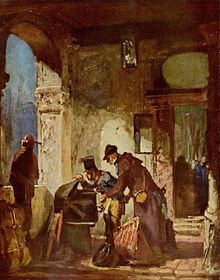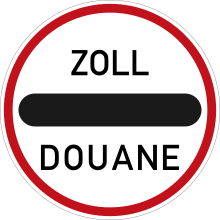Tariff
Customs (pl.: customs duties, derived from the Late Latin, synonymous teloneum) is the term for a duty that is required when goods are physically brought across a customs border.
Customs duties are taxes within the meaning of the German Tax Code. Customs duties should not be confused with import turnover tax (which corresponds to turnover tax, which is also added to any net price in Germany). Customs duty is an instrument of foreign trade policy. A historical form is the customs duty. The corresponding job title is customs officer.
Today, tariffs are predominantly viewed critically, as they hinder international trade in goods and lead to a loss of welfare within the framework of the theory of comparative cost advantages. Under the General Agreement on Tariffs and Trade, tariffs have been significantly reduced worldwide since 1947 and have become less important. However, under the GATT, tariffs are preferable to all other measures, such as quantitative restrictions (quotas) or subsidies. Tariffs have the advantage that their economic impact is relatively easy to measure. Under the most-favored-nation principle, any advantage, benefit, privilege, or exemption granted by a state for one product must be granted immediately and unconditionally for all like products from all countries. Thus, in determining the level of tariffs, no distinction may be made between trading partners, but only between products. However, exceptions are possible, for example vis-à-vis developing countries or within a customs union.
In particular, the revenue purpose (fiscal or financial customs duty) has increasingly receded into the background. Today, the focus is on the function of customs to protect selected domestic industries (protective tariff). The educational tariff is designed to protect new industries in a country by imposing a tariff, with the tariff being reduced as the industries become more competitive. Punitive duties (retaliatory duties) may also be imposed as an anti-dumping or anti-subsidy measure.
There is also a distinction according to the basis of assessment. Specific duties are levied per unit of a good, such as by mass, volume or number of pieces. Ad valorem duties are a percentage of the price of the good, and mixed duties include both instruments.
In countries with a high share of an informal economy (many underdeveloped countries), little transport and consumption tax is collected by the state and proportionally more customs revenue. A reduction in customs duties therefore weakens tax revenues and the financial strength of these countries, leads to increased imports of goods and to a negative foreign trade balance. When importing (mainly) agricultural products without protective tariffs, small local producers are in competition with producers from industrialised countries, whose products are often additionally subsidised (as by the EU and the USA).

Pictogram customs in travel

Uniform of a Roman customs guard (Beneficarius) - reconstruction

Customs cruiser Glückstadt in front of the German Customs Museum in Hamburg
History
Customs duties have existed for a very long time; as early as antiquity and the Middle Ages, they were mostly levied in the form of concurrence duties - comparable to a toll - with the emperor losing more and more sovereign rights to territorial lords (and thus the individual cities). In the age of mercantilism, tariffs were used specifically as an economic policy measure to protect the balance of payments and domestic producers. Prohibitive tariffs were intended to prevent the import of foreign products in the first place, educational tariffs to promote the development of domestic industry, and protective tariffs to protect it from (cheaper-producing) foreign competitors.
Since 1947, tariffs have been significantly reduced worldwide under the GATT. Since 1995, this has been done within the framework of the World Trade Organization.

Carl Spitzweg: Customs Inspection (Papal Customs Guard), c. 1880
Import, transit and export duty
General
A distinction is made between import (or import), transit (or transit) and export (or export) duties, depending on the movement of the goods on which a duty is levied. In most cases, the term customs duty refers to an import duty. These customs duties have become the most important. Through them, a state gains foreign currency (financial customs duty) or can protect domestic economic enterprises from foreign competition (protective customs duty).
According to Art. II GATT, Member States are obliged to set maximum tariffs (so-called contract duties) which will not be exceeded. Each Member State has established this in the form of a list indicating the maximum tariffs for certain products.
Transit duties are inadmissible under Art. V:3 GATT inadmissible. In order to facilitate transit traffic, trucks which only pass through a country without exporting anything to that country bear the TIR marking and are sealed. This does not apply to intermediate or raw products which are brought into an economic area, processed there and then re-imported into the original economic area (processing traffic).
Export duties are rarely imposed because it is usually in a country's interest to sell goods to foreign countries and thereby generate revenue. Export duties make the export of goods more expensive and thus reduce it. Especially for developing countries, however, there are reasons to impose export duties:
- they give the State a share of the revenue (fiscal reasons) if the exported product can be sold on the world market despite being subject to customs duties (e.g. rare raw materials),
- they prevent urgently needed scarce goods (shortages) from being exported instead of being sold on the domestic market (e.g. food),
- they can defuse trade disputes and possibly avert the imposition of import duties by another country (e.g. textiles).
The opposite of export duties are export subsidies.
Collection of import duties in Germany
Customs duties are collected by the customs authorities of a country. Customs offices are located at the central hubs of goods traffic. Most of these customs offices are stationary, e.g. in ports, airports, railway stations or border crossings. In addition, the customs administration is also active on a mobile basis through the KEV and KEG (control units traffic and control units border area), for example on motorways and interurban roads.
The import procedure is divided into the following steps:
- Bringing the goods into the country (in doing so, the customs road constraint must be observed)
- Presentation of the goods
- Entry summary declaration (ESumA) of the goods
- Customs declaration
- Examination and acceptance of the customs declaration
- possibly inspection of the goods (target: 5 percent of the goods)
- payment of import duties (customs duties, import turnover tax, excise duties, etc.)
- surrender of the goods
Goods that are found to be dutiable or that cannot be conclusively assessed are taken into custody by Customs. The consignee or an authorised representative must provide the customs with requested documents and, if necessary, make the customs payment in order to have goods handed over.
An authorized agent can be, for example, Deutsche Post (assuming the corresponding order from the recipient/sender).
If no authorised representative is specified, customs handling is to be carried out by the consignee, which is known as self-clearance. Goods delivered by post may be labelled "self-customs" by customs and must then be handed in by the shipping company at the nearest customs office to the recipient's location. The consignee must then be informed by the "Notification of Receipt of a Consignment of Third Country Goods" (green card) by the shipping company. The consignee must then provide the information/documents specified in "Notice of Customs Handling of a Mail Item".
In Germany and the EU, customs clearance is possible at internal customs offices, whereas Switzerland only has customs clearance at the border, i.e. all goods traffic must undergo customs clearance at the border.

Sign 392 (customs office) from the German Road Traffic Regulations

TIR plate, e.g. on a lorry
Search within the encyclopedia